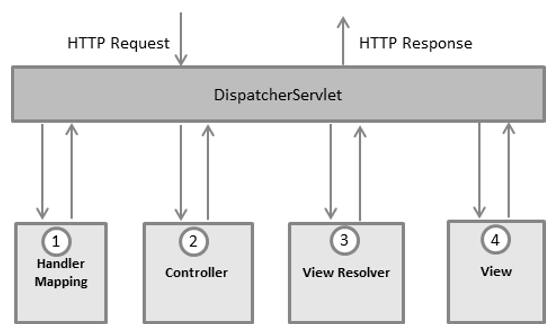The OLD XML Configuration
pom.xml. The jstl and servlet-api is only need if you use JSTL in your JSP pages.
<?xml version="1.0" encoding="UTF-8"?>
<project xmlns="http://maven.apache.org/POM/4.0.0"
xmlns:xsi="http://www.w3.org/2001/XMLSchema-instance"
xsi:schemaLocation="http://maven.apache.org/POM/4.0.0 http://maven.apache.org/xsd/maven-4.0.0.xsd">
<modelVersion>4.0.0</modelVersion>
<groupId>se.magnuskkarlsson.examples</groupId>
<artifactId>example-springmvc-xml</artifactId>
<version>1.0.0-SNAPSHOT</version>
<packaging>war</packaging>
<properties>
<project.build.sourceEncoding>UTF-8</project.build.sourceEncoding>
<project.build.outputEncoding>UTF-8</project.build.outputEncoding>
<maven.compiler.source>1.8</maven.compiler.source>
<maven.compiler.target>1.8</maven.compiler.target>
<failOnMissingWebXml>false</failOnMissingWebXml>
</properties>
<dependencies>
<dependency>
<groupId>org.springframework</groupId>
<artifactId>spring-webmvc</artifactId>
<version>5.1.2.RELEASE</version>
</dependency>
<dependency>
<groupId>javax.servlet</groupId>
<artifactId>jstl</artifactId>
<version>1.2</version>
</dependency>
<dependency>
<groupId>javax.servlet</groupId>
<artifactId>javax.servlet-api</artifactId>
<version>3.1.0</version>
<scope>provided</scope>
</dependency>
</dependencies>
<build>
<plugins>
<!-- embedded Jetty server, for testing -->
<plugin>
<groupId>org.eclipse.jetty</groupId>
<artifactId>jetty-maven-plugin</artifactId>
<version>9.2.11.v20150529</version>
<configuration>
<scanIntervalSeconds>10</scanIntervalSeconds>
<webApp>
<contextPath>/</contextPath>
</webApp>
</configuration>
</plugin>
</plugins>
</build>
</project>
web.xml. The old school, but is good to know, since there are several old references to the XML way.
<?xml version="1.0" encoding="UTF-8"?>
<web-app xmlns="http://xmlns.jcp.org/xml/ns/javaee"
xmlns:xsi="http://www.w3.org/2001/XMLSchema-instance"
xsi:schemaLocation="http://xmlns.jcp.org/xml/ns/javaee http://xmlns.jcp.org/xml/ns/javaee/web-app_3_1.xsd"
version="3.1">
<listener>
<listener-class>org.springframework.web.context.ContextLoaderListener</listener-class>
</listener>
<context-param>
<param-name>contextConfigLocation</param-name>
<param-value>/WEB-INF/spring/application-context.xml</param-value>
</context-param>
<servlet>
<servlet-name>DispatcherServlet</servlet-name>
<servlet-class>org.springframework.web.servlet.DispatcherServlet</servlet-class>
<init-param>
<param-name>contextConfigLocation</param-name>
<param-value></param-value>
</init-param>
<load-on-startup>1</load-on-startup>
</servlet>
<servlet-mapping>
<servlet-name>DispatcherServlet</servlet-name>
<url-pattern>/</url-pattern>
</servlet-mapping>
</web-app>
/WEB-INF/spring/application-context.xmlIn Spring you can split the Spring XML configuration into several files, but I tend to think that using several configuration files, will only make you wander lost in configuration, so I prefer one configuration file.
<?xml version="1.0" encoding="UTF-8"?>
<beans xmlns="http://www.springframework.org/schema/beans"
xmlns:xsi="http://www.w3.org/2001/XMLSchema-instance"
xmlns:context="http://www.springframework.org/schema/context"
xmlns:mvc="http://www.springframework.org/schema/mvc"
xsi:schemaLocation="http://www.springframework.org/schema/beans http://www.springframework.org/schema/beans/spring-beans.xsd
http://www.springframework.org/schema/context http://www.springframework.org/schema/context/spring-context.xsd
http://www.springframework.org/schema/mvc http://www.springframework.org/schema/mvc/spring-mvc.xsd">
<context:component-scan base-package="se.magnuskkarlsson.example.springmvc.controller" />
<mvc:annotation-driven />
<bean id="viewResolver" class="org.springframework.web.servlet.view.InternalResourceViewResolver">
<property name="prefix" value="/WEB-INF/view/" />
<property name="suffix" value=".jsp" />
</bean>
</beans>
Now the actual "app". Spring MVC design is much like Struts with one Servlet that dispatch request. HelloController
package se.magnuskkarlsson.example.springmvc.controller;
import org.springframework.stereotype.Controller;
import org.springframework.ui.Model;
import org.springframework.web.bind.annotation.RequestMapping;
import org.springframework.web.bind.annotation.RequestMethod;
import org.springframework.web.bind.annotation.RequestParam;
@Controller
public class HelloController {
@RequestMapping(value = "/hello", method = RequestMethod.GET)
public String hello(@RequestParam(value = "name", required = false, defaultValue = "World") String name,
Model model) {
model.addAttribute("name", name);
return "hello";
}
}
And your app view - WEB-INF/view/hello.jsp
<%@ page language="java" contentType="text/html; charset=UTF-8" pageEncoding="UTF-8"%>
<%@ taglib prefix="c" uri="http://java.sun.com/jsp/jstl/core"%>
<%@ taglib prefix="spring" uri="http://www.springframework.org/tags"%>
<%@ taglib prefix="form" uri="http://www.springframework.org/tags/form"%>
<!DOCTYPE html>
<html>
<head>
<meta charset="UTF-8">
<title>Hello Spring MVC</title>
</head>
<body>
<h2>Hello Java ${name}!</h2>
</body>
</html>
And finally lets test it by running 'mvn jetty:run' and open http://localhost:8080/hello?name=foo.
$ mvn clean install; mvn jetty:run
The NEW Java Configuration
Now we delete web.xml and /WEB-INF/spring/application-context.xml. And manually write code that do the same thing.
package se.magnuskkarlsson.example.springmvc;
import javax.servlet.ServletContext;
import javax.servlet.ServletException;
import javax.servlet.ServletRegistration;
import org.springframework.web.WebApplicationInitializer;
import org.springframework.web.context.ContextLoaderListener;
import org.springframework.web.context.support.AnnotationConfigWebApplicationContext;
import org.springframework.web.context.support.GenericWebApplicationContext;
import org.springframework.web.servlet.DispatcherServlet;
public class MainWebAppInitializer implements WebApplicationInitializer {
@Override
public void onStartup(ServletContext container) throws ServletException {
// Create the 'root' Spring application context
AnnotationConfigWebApplicationContext rootContext = new AnnotationConfigWebApplicationContext();
rootContext.scan("se.magnuskkarlsson");
// Manage the lifecycle of the root application context
container.addListener(new ContextLoaderListener(rootContext));
// Register and map the dispatcher servlet
ServletRegistration.Dynamic dispatcher = container.addServlet("dispatcher",
new DispatcherServlet(new GenericWebApplicationContext()));
dispatcher.setLoadOnStartup(1);
dispatcher.addMapping("/");
}
}
package se.magnuskkarlsson.example.springmvc;
import org.springframework.context.annotation.Bean;
import org.springframework.context.annotation.ComponentScan;
import org.springframework.context.annotation.Configuration;
import org.springframework.web.servlet.ViewResolver;
import org.springframework.web.servlet.config.annotation.EnableWebMvc;
import org.springframework.web.servlet.config.annotation.WebMvcConfigurer;
import org.springframework.web.servlet.view.InternalResourceViewResolver;
@EnableWebMvc
@Configuration
@ComponentScan(basePackages = { "se.magnuskkarlsson.example.springmvc.controller" })
public class AppConfig implements WebMvcConfigurer {
@Bean
public ViewResolver viewResolver() {
InternalResourceViewResolver bean = new InternalResourceViewResolver();
bean.setPrefix("/WEB-INF/view/");
bean.setSuffix(".jsp");
return bean;
}
}

No comments:
Post a Comment